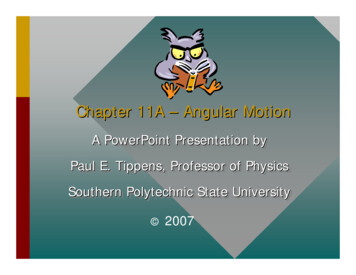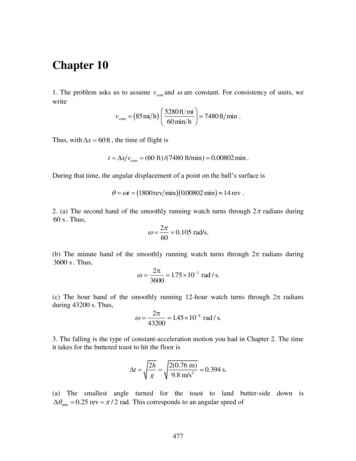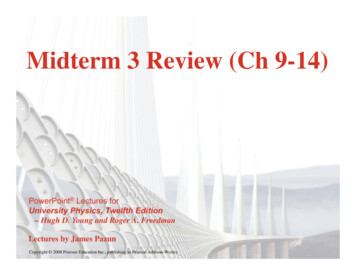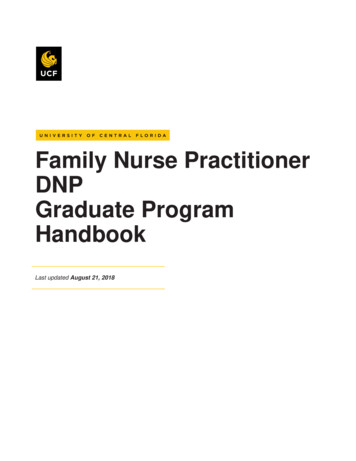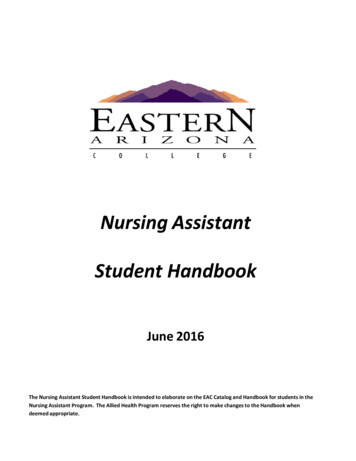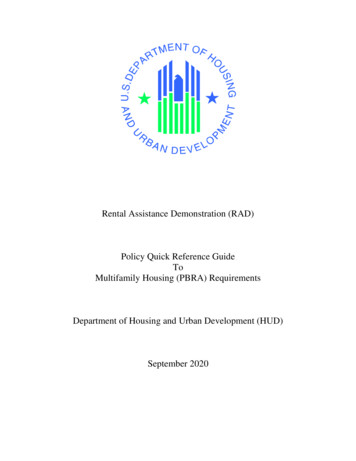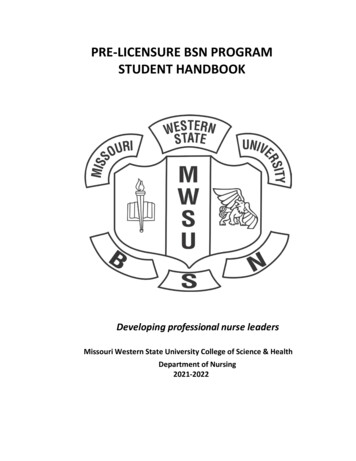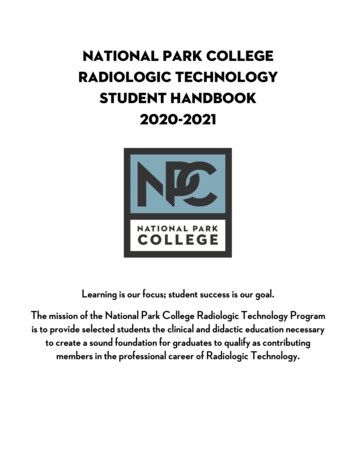
Transcription
NATIONAL PARK COLLEGERADIOLOGIC TECHNOLOGYSTUDENT HANDBOOK2020-2021Learning is our focus; student success is our goal.The mission of the National Park College Radiologic Technology Programis to provide selected students the clinical and didactic education necessaryto create a sound foundation for graduates to qualify as contributingmembers in the professional career of Radiologic Technology.
INTRODUCTION AND WELCOME4nPC RADIOLOGIC TECHNOLOGY FACULTY5PROGRAM MISSION6PHILOSOPHY AND GOALS6TYPE OF PROGRAM7DEGREE GRANTED7LENGTH OF PROGRAM7MASTER PLAN OF EDUCATION8ACADEMIC HONESTY8RADIOLOGIC TECHNOLOGY COGNITIVE/PHYSICAL CAPABILITY REQUIREMENTS9-11JRCERT11DESIGNATED Lines OF AUTHORITY12RADIOLOGIC TECHNOLOGY CLASSROOM13-24METHODS OF INSTRUCTION14GRADING SCALE15ATTENDANCE POLICY15DRESS CODE15CELL PHONE POLICY16CONCEAL/CARRY POLICY16ZOOM POLICY17-19TEXTBOOK LIST19-22GRADUATIOM/PInnInG REQUIREMENTS22ENERGIZED LAB SAFETY AND USE POLICY23CLINICAL EDUCATIONAFFILIATE CLINICAL FACULTY AND EDUCATION CENTERSCLINICAL EDUCATION SEMESTERS24-6325-2828FIRST SEMESTER28SECOND SEMESTER29THIRD SEMESTER30FOURTH SEMESTER30FIFTH SEMESTERCLINICAL ROTATIONSGENERAL CLINICAL OBJECTIVES3131-33331
FLUOROSCOPY Rotation OBJECTIVES35PORTABLE/MOBILE AND SURGERY ROTATION OBJECTIVES36COMPUTERIZED TOMOGRAPHY Rotation OBJECTIVES37Interventional Rotation OBJECTIVES37MAMMOgraphy/BONE DENSITOMETRY ROTATION OBJECTIVES38MAMMOGRAPHY POLICY40STUDENT CLINICAL RECORDS41Clinical GRADING SCALE41CLINICAL PATIENT DAILY EXAMINATION ENTRIES41PERFORMANCE EVALUATIONS41COMPETENCY EVALUATION PROCEDURE41Competency Grading Criteria41SIMULATION EXAMINATIONS42FINAL CATEGORY COMPETENCY42MINIMUM COMPETENCY NUMBERS PER SEMESTER43CLINICAL SUPERVISION/REPEAT RADIOGRAPHS POLICY44RADIATION PROTECTION POLICY46RADIATION DOSIMETRY47USE, WEAR AND STORAGE OF YOUR DOSIMETERPROCEDURE FOR EXCESSIVE DOSAGECLINICAL ATTENDANCETARDY47505151-52UNIFORM GUIDELINES51MARKERS52INSURANCE COVERAGE AND ACCIDENTS53REGULATIONS REGARDING BLOOD BORNE PATHOGENS53ACCIDENTAL EXPOSURE TO BLOOD OR BODY FLUIDS54COMMUNICABLE DISEASES GUIDELINES55STUDENT REFUSAL TO CARE56PREGNANT STUDENT POLICY57TECHNIQUE CHART ASSIGNMENT60CLINICAL DISCIPLINARY POLICY AND GROUNDS FOR PROBATION AND DISMISSALRemoval from a Clinical Education Center:Probation Guidelines616161-622
Dismissal Guidelines61ADDITIONAL INFORMATION63STUDENT GRIEVAMCE PROCEDURE64Informal Grievance64Formal Grievances65EXIT PROCEDURE FOR AnY REASONPolicies6667ACADEMIC HONESTY POLICY68EQUAL OPPORTUNITY AND AFFIRMATIVE ACTION POLICY68THE HEALTH INSURANCE PORTABILITY & ACCOUNTABILITY ACT OF 1996THE FAMILY EDUCATION RIGHTS AND PRIVACY ACT OF 1974Educational Records70-727272SEXUAL HARASSMENT Policy74HEALTH SCIENCES DIVISION REPONSIBLE USE SOCIAL MEDIA POLICY75SUBSTANCE ABUSE POLICY78TESTING PROCEDURES78WHEN THE TESTING MAY OCCUR:80COST80FACILITY80SAMPLE COLLECTION80SUBSTANCES80POSITIVE RESULTS81CONFIDENTIALITY81TREATMENT, REFERRAL & REAPPLICATION81INCIDENT OF REOCCURRENCE82DRUG TESTING FOR CAUSE81SUBSTANCE ABUSE POLICY REFERRAL LIST83-84MEDICAL MARIJUANA Policy84Service Animals Policy853
INTRODUCTION AND WELCOMEWelcome to the Associate degree Radiologic Technology Program at National ParkCollege. We are proud of the program and of the achievement of its graduates.This health care career program is one that takes time and dedication. The faculty andcounselors are available to assist you throughout your training. We wish you successand personal growth through your experiences in this program.This handbook is designed to serve as your guide to general information concerning theprogram in those areas that directly affect your life as a student in this curriculum. Thecontents of the handbook represent a statement of the policies and procedures fromthe faculty to you and are intended to serve as a supplement to the National ParkCollege Catalog and the NPC Student Handbook. You are required to study this bookand be completely familiar with all of its parts. This handbook will assist you withanswers to the many questions that are likely to arise each year relative to the policiesof the program and its clinical affiliates.Students enrolled at National Park College's Program of Radiologic Technology will beresponsible for observing all rules of conduct as stated in the college catalog.Additional rules of behavior are outlined in this manual and will be adhered to at alltimes. These rules are also in effect at all clinical sites. All clinical sites are consideredpart of the college while students are present. Failure to comply with the rules andregulations in this handbook may result in dismissal from the program.The policies and procedures expressed in this handbook reflect those in existence atthe time this handbook went to press. The College and Division of RadiologicTechnology reserve the right to change policies at any time without prior notice.If a policy or procedure changes, you will be notified of the updated policy and orprocedure in writing and affirmation of understanding will be obtained.4
nPC RADIOLOGIC TECHNOLOGY FACULTYJanice Ivers, MSNDean of Nursing and Health SciencesOffice Phone: 501-760-4289Debra Wilson, MEd, BSRT, R.T.(R)(M)Program DirectorOffice Phone: 501-760-4285Cell: 501-617-4050Carla Kelley, MEd, BSRT, R.T.(R)(M)Clinical CoordinatorOffice Phone: 501-760-4286CelI: 501-609-6906Kelly Stringer, BS, R.T. (R)Clinical InstructorCell: 501-844-67935
PROGRAM MISSIONThe mission of the Radiologic Technology Program at National Park College is toprovide selected students the clinical and didactic education necessary to create asound foundation for graduates to qualify as contributing members in the professionalcareer of Radiologic Technology.PHILOSOPHY AND GOALSThe profession of Radiologic Technology is dedicated to the conservation of life, healthand the prevention and treatment of disease. The well-qualified technologist has theknowledge and skill to perform all related technical duties and the opportunity todevelop health programs.The goals of the program are as follows:1.2.3.4.Students/ graduates are clinically competent.Students possess critical thinking skills.Students are professional.Students communicate effectively.It is the purpose and aim of this program to provide the students with the finest trainingpossible so they may develop their academic capacity, their technical skill, and theirprofessional image. They should be concerned with a belief in their own worth; theymust be flexible, responsible and intelligent. The students must develop an ability towork alone and with others for the common good of the patient. They must learn selfdiscipline and have an unselfish pride in their work. If, through excellent academic andtechnical training, the students achieve a sense of meaning and purpose, as well as skillin their profession, the purpose and aims of this program will have been accomplished.Upon successful completion of classroom studies and clinical experience, the studentswill be eligible to take the National Registry Examination, American Registry ofRadiologic Technologists, leading to certification as a Registered RadiologicTechnologist.In order to assure moral standards, the ARRT states that a professional RadiologicTechnologist:6
"Be a person of good moral character and must not have engaged in conduct that isinconsistent with the ARRT Rules of Ethics". For further information on the ARRT, call(651) 687-0048 or visit www.arrt.org/TYPE OF PROGRAMThe Radiologic Technology Program is a two-year college based program, whichincludes clinical experience and didactic instruction in all aspects of the field of medicalimaging. Upon successful completion of the program, an Associate of Applied Sciencein Radiologic Technology will be awarded. This program involves five consecutivesemesters of academic studies and coordinated clinical practice at recognized clinicalaffiliates in order to complete requirements of the Joint Review Committee onEducation in Radiologic Technology (JRCERT). The program is accredited by theJRCERT. Information regarding the Standards is located at http://www.jrcert.org. Theprogram's Master Plan of Education is on file in the program director's office and isavailable for review by interested parties upon request.All Radiologic Technology courses and required pre-requisite courses must be passedwith a grade of "C" or better in order to progress in the Radiologic TechnologyProgram. Students who are unsuccessful in any coursework or clinical education on thefirst attempt may only reapply the following year to the Radiologic TechnologyProgram. The reapplication process does not guarantee acceptance into the program.The student will be required to meet with college faculty and successfully passcomprehensive examinations for each class the student has previously successfullycompleted. If unsuccessful, the course must be repeated.DEGREE GRANTEDUpon successful completion of the program, an Associate of Applied Science inRadiologic Technology will be awarded.LENGTH OF PROGRAMThis program involves five consecutive semesters of academic studies and coordinatedclinical practice at recognized clinical affiliates to complete requirements of the JointReview Committee on Education in Radiologic Technology. (JRCERT)7
MASTER PLAN OF EDUCATIONA Master Plan of Education is on file in the Program Director's Office and is availablefor review upon request.The schedule, policies and assignments in this program are subject to change. Theinstructors will always inform the students of any changes in a timely manner.ACADEMIC HONESTYAcademic integrity is a vital element of any learning community. NPC faculty holdthemselves to the highest standards in this regard and expects their students to do thesame. Students who compromise the integrity of academic inquiry are subject todisciplinary action on the part of the College. A violation of academic honesty mayinclude (but is not limited to) the following:1. Cheating on examinations, quizzes or other work;2. Plagiarism-the use of another's intellectual property (thought, writing, etc.)without proper reference/citation, whether directly quoted or paraphrased;3. Giving or receiving unauthorized assistance during a test or laboratory testing;4. Falsification, forgery, or alteration of academic recordsPenalties for breaches of academic integrity may include receiving an F for theassignment in question, receiving an F for the course, and/or dismissal from the course.In extreme cases, the administration reserves the right to suspend the student from allstudies at the College.8
RADIOLOGIC TECHNOLOGYCOGNITIVE/PHYSICAL CAPABILITY REQUIREMENTSEach new student should be informed about the physical, mental and emotionalcapacities one must possess in order to perform the duties and tasks of a RadiologicTechnologist. If you have questions or wish to discuss these physical capabilityrequirements, contact the Program Director.AMBULATION, LIFTING, MOVING AND STANDING: Propel wheelchairs, stretchers, IV poles, etc. alone or with assistance as available. Be ambulatory and able to maintain a center of gravity when met with anopposing force as in lifting, supporting and/or transferring a patient. Propel standard mobile imaging units and perform procedural tasks in a patient'sroom and/or surgical unit. Withstand lengthy periods of physical activity to include moving quickly and attimes, continuously.MANUAL DEXTERITY: Operate mechanisms such as imaging tables, x-ray tubes and other equipment. Manipulate both patient care devices and diagnostic equipment in a safe and timeefficient manner. Ability to work with arms extended above head and squat to the floor. Ability to move and manipulate the patient's body in order to provide patient careand patient support, and to position for imaging and/or treatment. Handle and utilize procedural items such as pharmaceuticals, vials, syringes,sterile items, catheters, intravascular materials and dressings. Handle and use image receptors, imaging mechanisms, adjunct radiologic items,etc. Access and use darkrooms of various standard designs; be able to load, unloadand process imaging films.VISUAL ACTIVITY: Performs patient identification, positioning, images field placement/alignmentand image analysis. Must be able to read written passages.9
Recognize visual cues that indicate patient distress when patient is unable tospeak.COGNITIVE ABILITIES: Communicate orally and in writing. Think clearly and prioritize assignments effectively to enhance patient safety andcomfort. Receive both oral and written communication and act appropriately upon receipt. Must be able to hear for reception of spoken communication. Perceive events realistically, think rationally and function confidently in routineand non-routine situations. Able to perform the above described cognitive functions in stressful situationsand life threatening emergencies.10
JRCERTIf, during your professional education, you feel the NPC Radiologic Technologyprogram does not comply with the JRCERT Standards you have the right to notify theJRCERT. Upon JRCERT notification of a complaint or allegation of non-compliance withJRCERT Standards, the Program Director shall evaluate the merit of the complaintand/or allegation and respond accordingly. The response will include supportingdocumentation of program compliance and/or methods by which the program hasresolved the issue.The JRCERT address is:Joint Review Committee on Education in Radiologic Technology20 North Wacker Drive, Suite 2850Chicago, IL 60606-3182312-704-5300 mail@jrcert.orgNational Park College at Hot Springs and the Division of Radiologic Technology doesnot discriminate on the basis of race, color, national origin, sex or qualified handicap inany of its policies, practices or procedures. This provision includes but is not limited toadmissions, employment, financial aid and other educational services. Inquiriesregarding Title IX, ADA, and Section 504 should be directed to the Vice President forStudent Affairs, 501-760-4203.11
DESIGNATED Lines OF AUTHORITYStudents are required to follow the designated lines of authority when dealing withconcerns, problems or conflicts associated with their nursing education.The designated lines of authority for nursing students are:1.2.3.4.5.Student or instructor directly implicated.Program Director.Dean of Nursing & Health Sciences.Vice President of Academic Affairs.President.12
RADIOLOGICTECHNOLOGYCLASSROOM13
METHODS OF INSTRUCTIONVarious methods of instruction will be utilized in all Radiologic Technology courses.These methods include lecture, Zoom lecture, class discussion, independent study,outside reading assignments, individual projects/ case studies and oral presentations.Additional instructional materials may be provided to supplement subject areas. Anyreading assignment should be completed before class in order to be prepared for classdiscussion and quizzes.Testing in all classes will consist of exams over lecture, class discussion, lab and anyother material presented or discussed in class. Testing and quiz format will includemultiple choice, listing, short answer, true/false, matching, essay, diagrams, fill in theblank, and crossword puzzles. The student is responsible for all content of chapterscovered based on syllabus. All testing is completed on computers. Any missedclassroom or lab quiz will result in a grade of zero (o). No exceptions.During RAD1404 Radiographic Procedures I, RAD 1704 Radiographic Procedures II,RAD 1803 Radiographic Procedures Ill and RAD 2503 Advanced RadiographicProcedures simulated laboratory practicals will be held. During these practicalsstudents will simulate examinations on fellow classmates. All practicals are videotapedfor review and discussion by students and faculty. Students will be required to watchand critique their video prior to receiving a grade.Exams will be given at the completion of each chapter/unit. Exams may be in a varietyof formats including multiple choice, matching, short answer and essay. Missed examsmust be completed prior to the next class and must be scheduled with instructor.Student must notify instructor that he/she will be absent from an exam. Failure to notifyinstructor will result in a grade of zero. Failure to complete exam prior to the next classwill result in a grade of zero. When the test is made up prior to the next class period, amaximum of 75% of grade made will be awarded. For instance, if you make a 100% on amakeup exam, the score will be recorded as a 75%. A comprehensive final exam will begiven in all courses. The final exams will constitute 25% of your overall course grade.Students must remain seated after testing until the entire group has completed testing.Do not leave the classroom after completion of your test.14
GRADING SCALEA minimum of 75% must be maintained in all courses in order to continue in theprogram. The grading scale is as follows:100-92 A91-83 B82-75 CBelow 75 DATTENDANCE POLICYAttendance is mandatory. If you are absent, you may miss a quiz or test and your gradewill suffer accordingly. Each tardy will be treated as an unexcused absence. A tardy inthe classroom or Zoom is defined as arriving past the scheduled starting time for class.The door will be closed and locked after the scheduled start time and the student willbe considered absent. Students will not be able to enter the classroom once class hasbegun, as this is disruptive to everyone. The door will reopen when class is over andstudents are on break, you may enter at that point. Arrive early to campus for theCOVID- 19 screening process at the front entrance.If attending class via Zoom, you must log in early to assure you have strong internetconnection and are ready for class. You must be seated at a desk or table, sittingupright with your light on. You must have your audio/camera turned on during classtime. Participation is mandatory.DRESS CODEStudents are expected to dress professionally while in the classroom and Zoom setting.Please exhibit modest style of clothing. Modest dress is essential due to role play andbending and stooping in the laboratory. No short shorts, no low cut shirts, or no halfshirts are allowed in classroom. No profanity on clothing allowed. No pajamas or robesallowed during Zoom class. You are representing the health care profession and mustbe professional at all times. Your NPC student ID and dosimeter must be worn at alltimes.15
CELL PHONE POLICYCell phones or smart watches will not be visible at any time during class. The deviceswill always remain on silent. Any disruption of class from a cell phone ringing orvibrating will result in a written warning. Cell phones/smart watches will all be placed inthe wall rack during class time. Taking pictures of any tests is prohibited and studentswill be dismissed for academic cheating. Tests can only be viewed one time after testingwhile student is still in classroom.CONCEAL/CARRY POLICYRadiologic technology students will follow the National Park College policy onconceal/carry while on campus. Students must abide by the conceal/carry policies ofeach clinical site location.16
NATIONAL PARK COLLEGEDIVISION OF NURSING & HEALTH SCIENCESZOOM POLICYDue to the guidelines for social distancing during the COVID-19 pandemic, ZOOMtechnology is being used in this course. Students should check the NPC Corona VirusUpdates at www.np.edu for any official updates & announcements related to thepandemic. If classes cannot meet on campus, faculty will inform students of the plan forhow coursework will continue.Lecture Class MeetingsALL lecture/theory class meetings will take place in the assigned classroom to maintainsocial distancing. Students should bring their laptop device to class each day as facultywill use ZOOM technology to teach to students in each classroom. Students in the"ZOOM" room will connect via ZOOM.Guidelines for Students in the Nursing & Allied Health Campus"ZOOM" RoomsStudents must be logged into the Zoom classroom five minutes before class isscheduled to begin. At the end of class, faculty will take attendance again. If you are notpresent at the end of the class meeting, you will be considered absent. If you must leavethe classroom early, you need to notify the course coordinator by course messages inD2L. Please do not 'leave the meeting' before class has ended. Attendance will be takenat the beginning of class. You must log into the class using a webcam to be considered'present'. Faculty must see your face for attendance.Connecting by ZOOM remotelyIf students and faculty must use ZOOM to connect remotely, please note the following:Please try to minimize background noise (ex: television, pets etc.). Your face should bevisible in the screen and you should avoid activities that could be distracting to theinstructor or other participants.No smoking, vaping, or drinking alcohol while in the "ZOOM" classroom.Be mindful that when using the webcam, everyone can see everyone else. Proper attirewill be expected.Make every attempt to secure daycare or sitter arrangements for children, assure petsare fed/walked, and family knows that you are in class.17
Classroom etiquette rules apply while in the " ZOOM " classroom (on campus orremotely) All students should have their audio muted during lecture to minimizebackground noise. Cell phones should be on silent and no texting or web surfing duringclass.Faculty will provide break times during class. You will not need to log off. You can stepaway from the computer but please be back and ready at the time given.18
TEXTBOOK LISTPatient Care in Radiography, 9th EditionRuth Ann Ehrlich, RT (R) and Dawn M CoakesISBN: 9780323353762This book will be used in 1st and 4th semester.Merrill’s Atlas of Radiographic Positioningand Procedures- 3 Volume Set, 14th EditionBruce W. Long, MS RT(R)(CV), FASRT,Jennean Hall Rollins, MRC, BSRT(R)(CV) andBarbara J. Smith, MS RT(R)(QM), FASRT, FAEIRSISBN: 9780323566674This book will be used in all semesters.Workbook for Merrill’s Atlas of RadiographicPositioning and Procedures, 14th EditionBruce W. Long, MS RT(R)(CV), FASRT,Barbara J. Smith, MS RT(R)(QM), FASRT, FAEIRSand Tammy Curtis, PhD, RT(R)(CT)(CHES)ISBN:9780323597043This book will be used in all semesters.19
Radiation Protection in MedicalRadiography, 8th EditionMary Alice Statkiewicz Sherer Paula Visconti E.Russell Ritenour Kelli Welch HaynesISBN: 9780323446662This book will be used in the 2nd semester.Workbook for Radiation Protection inMedical Radiography 8th EditionMary Alice Statkiewicz Sherer Paula Visconti E.Russell Ritenour Kelli HaynesISBN: 9780323555098This book will be used in the 2nd semester.Principles of Radiographic Imaging:An Art and a Science, 6th EditionRichard R. Carlton, Arlene M. Adler, Vesna BalacISBN: 9781337711067This book will be used in the 2nd, 4th, and 5th semester.Digital Radiography and PACS 3rd EditionChristi Carter Beth VealeISBN: 978032354758120
This book will be used in the 5th semester.Mosby's Comprehensive Review ofRadiography, 7th EditionWilliam J. Callaway, MA, RT(R)ISBN: 9780323354233This book will be used in the 5th semester.21
GRADUATIOM/PInnInG REQUIREMENTSIn order to complete the Associate of Applied Science degree in RadiologicTechnology, students must complete all coursework with a "C" or better. To be eligibleto take the ARRT Registry Exam (American Registry of Radiologic Technologists), allacademic requirements for graduation and all clinical criteria must be successfullycompleted. No student will be recommended to test for the registry examination untilthese requirements are met.All first-year students will serve at the graduating class pinning ceremony which is heldin May. Students completing the AAS degree in Radiologic Technology must participatein the May commencement ceremony. The program's pinning ceremony will also beheld in May. All graduating students are required to attend both the graduationceremony and the Radiologic Technology program pinning ceremony.22
ENERGIZED LAB SAFETY AND USE POLICYThe energized lab provides the Radiologic Technology student with the opportunity todevelop skill in imaging anatomical structures and to perform exposure experiments toassess equipment operation and radiographic techniques.1. Students may operate the energized lab only with an instructor present orimmediately available.2. Students may not radiograph each other. Students may simulate an examinationon another student as long as an exposure is not made. Phantoms and positioningdevices are available for laboratory simulations when exposures are made.3. Any individual simulation or project must be reviewed and authorized by a facultymember.4. The students are required to wear a radiation monitoring device while in theenergized lab and a NPC nametag.5. The students are required to wear a mask and face shield/goggles during labactivities.6. Any questionable practice must be reported to the program faculty immediately.7. No children or family members are allowed in the laboratory at any time.8. Before making a radiation exposure, be sure the door to the x-ray room is closedand the control panel is set correctly.9. If you notice anything unusual in the operation of the unit or its appearance (i.e.,loose wire), please report it to college faculty. The x-ray unit is calibrated toensure the unit meets federal and state guidelines for ionizing radiation units.10. Do not eat or drink in the laboratory or at the operating console. All food anddrinks must be left on the table immediately upon entering the room.11. Do not lose sight of the fact that you are working with heavy electrical equipmentand injuries can occur (i.e., hitting head on tube stand). Therefore, good conductis required when operating the unit. Should an injury occur, please report it to thecollege faculty at that time.23
CLINICALEDUCATION24
AFFILIATE CLINICAL FACULTY AND EDUCATION CENTERSMichael P. Hickman, M.D.Medical AdvisorHot Springs Radiology, Ltd.3633 Central Ave., #DHot Springs, AR 71913Phone: 501-623-6693National Park Medical Center1900 Malvern Ave.Hot Springs, AR 71901Paulette Johnson – DirectorDebbie Wright, R.T. (R) - onsite Clinical InstructorLacy Lenard, R.T. (R) - onsite Clinical InstructorDesiree Carranza, R.T. (R) - onsite second shift Clinical InstructorYvette Martinez, R.T. (R) - onsite second shift Clinical InstructorPhone: 501-620-2375CHI St. Vincent Hospital300 Werner St.Hot Springs, AR 71913John West – DirectorKeisha Wagenhauser BS, RT (R) - Manager, onsite Clinical InstructorJaclyn White R.T. (R) - onsite Clinical InstructorEmily Davidson R.T. (R) – onsite Clinical InstructorPhone: 501-622-1090; MIC 501-622-4884Baptist Health Medical Center - Hot Spring County1001 Schneider Dr.Malvern, AR 72104David Hennessee – DirectorMissy Smith R.T. (R) (CT) - onsite Clinical Instructor Phone: 501-332-7373Baptist Health Medical Center – Arkadelphia3050 Twin Rivers DriveArkadelphia, ARDavid Hennessee – DirectorMark Pickens R.T. (R) (CT) - onsite Clinical Instructor25
Shellie Cordero, R.T. (R) - onsite Clinical InstructorPhone: 870-245-1240Saline Memorial Hospital1 Medical Park Dr.Benton, AR 72075Lisa Hyde – DirectorKelsey Burke, R.T. (R) - onsite Clinical InstructorStacy Deimel, R.T. (R) - onsite Clinical InstructorPhone: 501-776-6182CHI St. Vincent Orthopedic Clinic1662 Higdon Ferry Rd., Ste. 300Hot Springs, AR 71913Kim Almond, R.T. (R) - onsite Clinical InstructorTwyla Nation, R.T. (R) - onsite Clinical InstructorPhone: 501-321-2663Orthopedic Center of Hot Springs704 Hollywood AvenueHot Springs, AR 71901Kim Diehl, R.T. (R) - onsite Clinical InstructorPhone: 507-327-0555CHI St. Vincent Primary Care Clinic2825 Albert Pike Rd.Hot Springs, AR 71913Rosaland Speers, R.T. (R) - onsite Clinical Instructor Phone: 501-767-9111Ouachita Procedure Center115 Wrights St.Hot Springs, AR 71913Tracy Puckett, R.T. (R) - onsite Clinical InstructorOffice Phone: 855-275-6374Tracy's Cell: 501-318-3340Touchstone Imaging3633 Central Avenue #100Hot Springs, AR 7191326
Glen Mayer, R.T. (R) - onsite Clinical InstructorPhone: 501-623-6736First Care Walk-In Clinic120 Adcock Rd., Ste. AHot Springs, AR 71913Courtney Stevens, R.T. (R) - onsite Clinical InstructorBarbara Malone, R.T. (R) - onsite Clinical InstructorPhone: 507-657-4500These facilities are recognized as clinical affiliates with the Radiologic Technology Programat National Park College.27
CLINICAL EDUCATION SEMESTERSThe purpose of clinical education is to assist the student in transferring knowledge fromthe didactic portion of the program into the clinical setting and applying thatknowledge. To better prepare students for the work force, students will be givenresponsibilities in the areas of self-direction and self-motivation.Opportunities for attaining competence in pediatric, geriatric, trauma, surgical andbedside procedures are provided. Simulation is utilized for infrequent or limited volumeexaminations and will comprise a minor element of clinical education. Opportunities areprovided for observation in computed tomography, cardiovascular interventional,magnetic resonance imaging, nuclear medicine, ultrasonography, positron emissiontomography, mammography and dual energy x-ray absorptiometry. These modalitiesare scheduled by college faculty. Students may not observe/participate in these areasunless assigned.A student is permitted to log any exam he/she observes and/or participates in duringclinical education, even if the exam has not been covered in class. The student cannotprove competency on any exam prior to testing in the classroom. Once the student hastested, he/she will then be allowed to perform competency.Students are not compensated for clinical education experiences at any facility at anytime.FIRST SEMESTERClinical education is a continual progression. The first six weeks of clinical (Tuesdaysand Thursdays) are spent preparing th
Interventional Rotation OBJECTIVES 37 . The policies and procedures expressed in this handbook reflect those in existence at the time this handbook went to press. The College and Division of Radiologic . Radiologic Technologists, leading to certification
